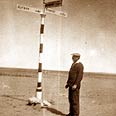
A. During palm trip to Persia: Ben-Zion standing near signpost on Ramadi-Rutba intersection
Palm man's travels
Ben-Zion Israeli risked his life when he went on missions on behalf of Zionist settlement to Egypt, Iraq, Kurdistan and Persia, in bid to bring high quality palm species to Land of Israel, but was later killed in unfortunate accident in Kibbutz Ma'agan. Second and last story in series
In this article we continue the story of Ben-Zion Israeli (1887-1954). In the previous article we were introduced to Ben-Zion's "palm trips" to Egypt, Iraq, Kurdistan and Persia in a bid to bring palm species to the Land of Israel and revive the palm growing industry.
In the first part of this article we present photographs documenting Ben-Zion's trips to Persia and Iraq in 1935 and 1936, during which he purchased thousands of palm branches and brought them to Israel after many hardships.
In the second part of the article we follow the palm trip from Iraq to Israel in 1954, which Ben-Zion did not live to complete.
Ben-Zion's last palm trip occurred after the State's establishment, in 1954. He went on this trip with Yani Avidav of Nahalal. Avidav was a member of Mossad Le'aliyah Bet (Institution for Immigration B), which brought illegal Jewish immigrants to the Land of Israel before the State's establishment, and was involved in the Haganah defense association's purchase operations.
Later that year, Ben-Zion returned to Kinneret for a short visit. He took part in a rally in memory of the paratroopers from the Land of Israel killed in World War II in Europe, which took place near Kibbutz Ma'agan. During the event, a Piper aircraft in the midst of an aerobatics show crashed into the audience. Ben-Zion was among the casualties. After Ben-Zion's death, Yani Avidav decided to complete the mission.

1. 1936, at the railway station in Basra, Iraq. Loading the palm plants on the train wagons










Throughout the years, when the palm trees were no longer fruitful, they were transferred in one piece as ornamental trees to decorate the entrance to Ben-Gurion Airport and the area near the southern city of Dimona. In the photo: One of the plant nurseries

Zion Mualem, who appears in photo No. 3, immigrated to Israel at some point. We are looking for information about him and would be happy if our readers could help us.
- For all trips to the past – click here










